In the medical field, ancillary items are essential tools that support primary medical procedures and enhance patient care. Though they may not always be the star of the show, these items serve a vital function in ensuring the smooth and safe operation of healthcare services. Ancillary items help medical professionals perform tasks efficiently, maintain hygiene and safety standards, and ensure that the patient’s needs are met throughout their treatment.

A Diverse Range of Ancillary Items
Ancillary items come in various forms and serve a multitude of functions in healthcare environments. These items are often categorized into support tools for medical procedures, patient care products, and facility management items. Common examples include bandages, dressings, syringes, gloves, surgical drapes, and medical tape. These items help medical teams perform their jobs while ensuring that the patient remains comfortable and safe.
One example of an ancillary item is surgical drapes, which are used to cover patients or operating tables to create a sterile environment. They are designed to protect both the patient and the surgical team from contamination. Likewise, sterile gloves and gowns are worn by medical staff to prevent the spread of bacteria and viruses. In a similar vein, disposable syringes and needles allow healthcare providers to administer fluids and medications safely to patients, minimizing the risk of contamination or cross-infection.
The Role of Ancillary Items in Surgical Procedures
In surgeries, the need for precision and cleanliness cannot be overstated. Surgical drapes, sponges, and towels are integral in maintaining a sterile environment, ensuring the procedure can proceed without complications. Surgical drapes are designed to be placed over the patient, covering only the area of the body involved in the procedure, thus minimizing exposure to potential infections.
Other ancillary items, such as retractors and forceps, assist the surgical team by holding back tissues or organs to provide the surgeon with a clear view of the area being treated. These instruments often work in tandem with the primary tools, enhancing the surgeon’s ability to perform precise and controlled procedures. In addition, suction devices are commonly used to remove blood or fluids from the surgical site, ensuring that the area remains visible and free from obstructions.
Supporting Patient Recovery with Ancillary Items
After a procedure is completed, the importance of ancillary items continues in patient recovery. Items such as bandages, gauze, and wound dressings are used to protect the incision sites, prevent infections, and promote healing. Additionally, pain management tools such as ice packs, analgesic creams, and compression wraps are used to provide comfort and reduce swelling.
For patients who require additional support during their recovery, ancillary items like crutches, mobility aids, and post-surgery braces are essential for aiding movement and ensuring that patients can safely navigate their surroundings as they heal. In cases of rehabilitation, tools like physical therapy bands, heat packs, and exercise balls help patients regain strength and flexibility.
The Impact of Ancillary Items on Patient Care and Safety
The safety and effectiveness of any medical treatment rely not only on the expertise of healthcare providers but also on the quality of the tools they use. The quality of ancillary items is paramount in achieving positive outcomes. Medical items must be sterile, durable, and specifically designed to serve their purpose. Substandard or improperly used ancillary items can increase the risk of infection, cause unnecessary pain, or delay recovery.
In many healthcare settings, ancillary items are subject to stringent regulations to ensure their effectiveness and safety. These regulations may include testing for durability, ease of use, and sterilization capabilities, as well as compliance with national and international safety standards. Proper storage and handling of ancillary items are equally important, as mishandling or poor storage conditions can compromise the safety and functionality of these essential products.
Conclusion
Ancillary items are an indispensable part of healthcare, providing the necessary support to enhance patient care and the functionality of medical procedures. These items, ranging from surgical drapes to wound dressings, play a vital role in maintaining safety, hygiene, and efficiency in healthcare environments. Without these supporting tools, medical professionals would face significant challenges in performing their tasks effectively. Whether during surgery, in recovery, or in the day-to-day care of patients, ancillary items help ensure that medical treatments are carried out safely and successfully, leading to better outcomes for patients.